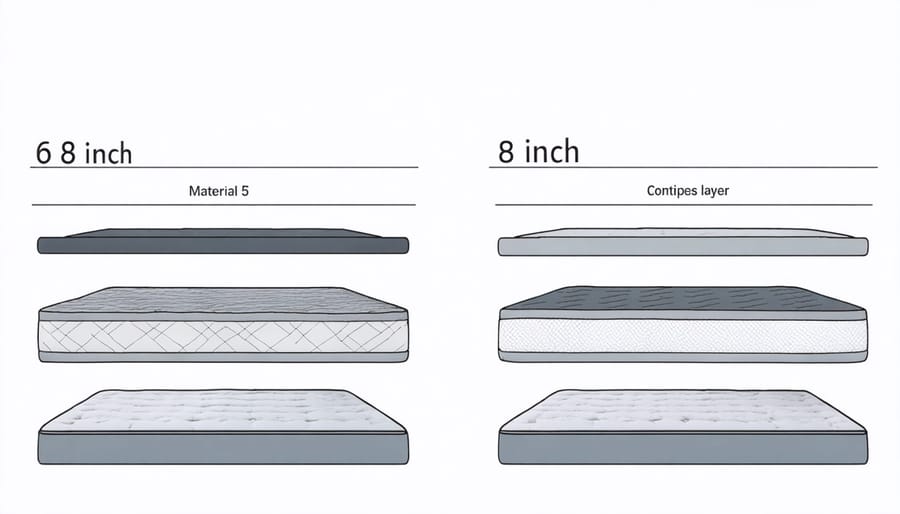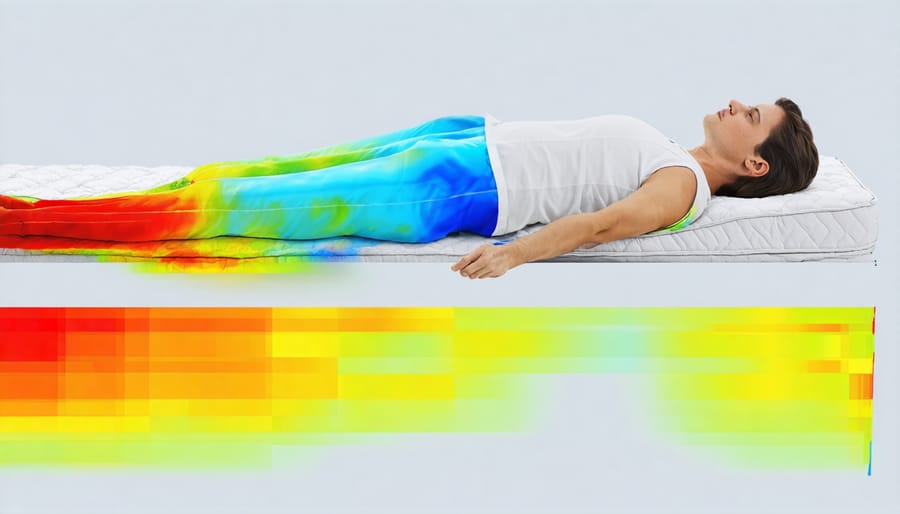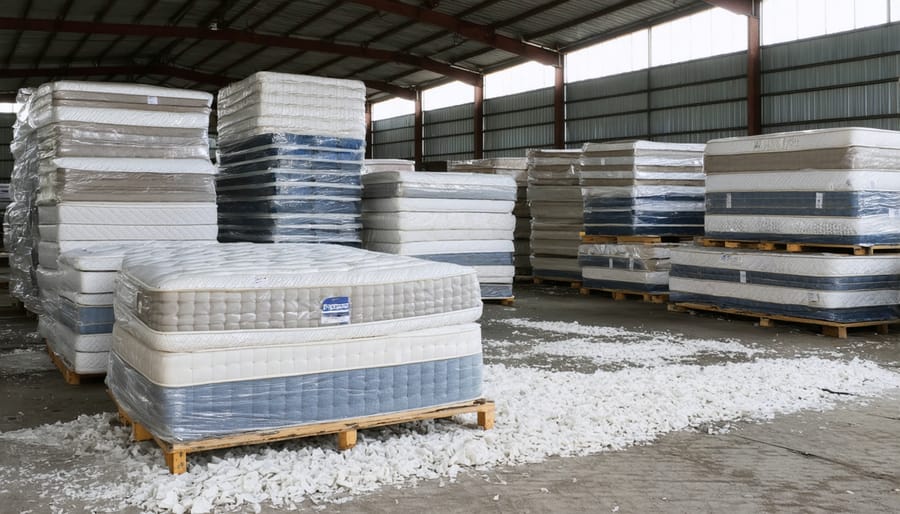Making environmentally conscious choices in mattress shopping starts with understanding the crucial differences between 6-inch and 8-inch options. The thickness of your mattress impacts not only your sleep quality but also its environmental footprint and longevity.
For side sleepers and those weighing under 80kg, a 6-inch mattress often provides adequate support while using fewer materials and creating less waste. The thinner profile makes these mattresses easier to move, ship, and eventually recycle. However, heavier sleepers and those seeking premium comfort often benefit from an 8-inch mattress’s additional support layers and pressure distribution.
Consider that 8-inch mattresses typically last 2-3 years longer than their 6-inch counterparts, potentially reducing long-term environmental impact through less frequent replacement. While they require more resources initially, their extended lifespan can make them a more sustainable choice for many Australian households.
This guide explores how these thickness options affect comfort, durability, and environmental impact, helping you make an informed decision that aligns with both your comfort needs and sustainability goals.
Material Efficiency and Environmental Impact
Resource Consumption Comparison
When comparing 6-inch and 8-inch mattresses, the difference in material consumption is quite significant. The 8-inch mattress typically requires 33% more raw materials, including foam, fabric, and binding materials. For a standard queen-size mattress, this translates to roughly 2-3 kilograms of additional materials per unit.
In the Australian context, where we’re increasingly mindful of our environmental footprint, this difference matters. The additional foam used in 8-inch mattresses requires more petroleum-based products in manufacturing, while the extra fabric and materials increase the overall resource demand. However, it’s worth noting that a thicker mattress might last longer, potentially balancing out the initial higher resource usage over time.
The manufacturing process for both sizes follows similar steps, but the 8-inch version requires approximately 20% more energy during production. This increased energy consumption contributes to a larger carbon footprint, though the exact impact varies depending on the manufacturer’s energy sources and production methods.
When considering disposal, thinner mattresses generally create less waste in landfills, though both sizes should ideally be recycled through local Australian mattress recycling programs to minimise environmental impact.

Manufacturing Energy Requirements
When it comes to manufacturing energy requirements, the difference between 6-inch and 8-inch mattresses is quite significant for our environment. The production of an 8-inch mattress typically requires about 25-30% more energy compared to its 6-inch counterpart, primarily due to the additional materials and processing time needed.
In Australian manufacturing facilities, the energy consumption mainly comes from the foam compression process and thermal bonding of materials. A 6-inch mattress goes through shorter compression cycles and requires less heat during production, resulting in lower electricity usage. This translates to approximately 12-15 kilowatt-hours less energy per mattress produced.
Local manufacturers have reported that producing 6-inch mattresses allows them to complete more units per energy cycle, making them a more resource-efficient choice. Some Australian mattress makers have even started highlighting these energy savings on their product labels, helping conscious consumers make informed decisions.
However, it’s worth noting that advances in manufacturing technology are gradually reducing this energy gap, with newer production methods becoming increasingly efficient for both thickness options.
Comfort and Support Analysis
Weight Distribution Properties
When it comes to mattress comfort and materials, thickness plays a crucial role in how your body weight is distributed during sleep. The 6-inch mattress typically offers a more concentrated weight distribution pattern, which can work well for lighter individuals or children. However, this thinner profile means there’s less material to absorb and disperse pressure, potentially creating more noticeable pressure points for adults or those carrying more weight.
The 8-inch mattress, with its additional layers, provides enhanced weight distribution properties that benefit most sleepers. This extra depth allows for better pressure point relief, particularly around shoulders, hips, and other areas where the body tends to press more heavily into the mattress. The additional material creates a more gradual compression zone, helping to maintain proper spinal alignment while reducing the likelihood of waking up with aches and pains.
For side sleepers especially, the difference becomes more pronounced. The 8-inch option offers more room for the shoulders and hips to sink in appropriately without bottoming out, while the 6-inch version might feel too firm in these high-pressure areas. Back sleepers might find either option suitable, though the 8-inch provides more consistent support across the entire body surface.
Remember that your body type and sleeping position should guide your choice, as proper weight distribution directly impacts both comfort and long-term spinal health.

Durability Factors
When it comes to mattress longevity, thickness plays a crucial role in determining how well your sleep surface stands up to daily use. The 8-inch mattress typically offers better durability than its 6-inch counterpart, primarily due to its additional support layers and material density. This extra thickness provides more room for high-quality materials and better weight distribution, which can help prevent sagging and maintain shape over time.
For our Aussie climate, which can be quite demanding with humidity and temperature fluctuations, the 8-inch option tends to be more resilient. The additional layers help protect the core materials from moisture and wear, potentially extending the mattress’s lifespan by 1-2 years compared to a 6-inch version.
However, proper maintenance matters more than thickness alone. A well-cared-for 6-inch mattress can outlast a neglected 8-inch one. Regular rotation, using appropriate bed bases, and maintaining a clean environment all contribute to longevity. Both options can serve you well when paired with good care practices.
For those living in apartments or units where mattress replacement might be challenging, considering the durability factor becomes even more important. The 8-inch mattress generally provides better value for money in terms of lifespan, though this needs to be balanced against your specific needs and circumstances.
Remember that investing in a quality mattress, regardless of thickness, often proves more sustainable in the long run, reducing the frequency of replacements and ultimately minimizing waste.
Transport and Storage Efficiency
Carbon Footprint in Transit
When it comes to transport emissions, the difference between 6-inch and 8-inch mattresses might seem minimal, but it adds up significantly across Australia’s vast distances. The thinner 6-inch mattress allows for approximately 25% more units per delivery truck, resulting in fewer trips and reduced fuel consumption. This efficiency in transport means lower carbon emissions per mattress delivered to your doorstep.
For example, a standard delivery truck can typically fit 30-35 6-inch mattresses compared to 22-26 8-inch mattresses. This difference becomes particularly important when considering deliveries to regional areas like the Outback, where trucks often travel thousands of kilometres. By choosing the 6-inch option, you’re contributing to reducing packaging waste and transport emissions.
Local mattress manufacturers in major cities like Sydney and Melbourne have reported that switching to 6-inch models has helped them decrease their transport-related carbon emissions by up to 20%. This reduction is especially meaningful for our country’s commitment to lowering greenhouse gas emissions while maintaining efficient delivery services across our widespread population centres.
Storage Space Requirements
The difference in thickness between 6-inch and 8-inch mattresses significantly impacts storage efficiency in both commercial and residential settings. Australian retailers and warehouses can store approximately 25% more 6-inch mattresses in the same vertical space compared to their 8-inch counterparts. This translates to reduced storage costs and a smaller carbon footprint for businesses managing inventory.
For local retailers, particularly those in urban areas where space comes at a premium, the ability to stock more 6-inch mattresses means better utilization of showroom floor space. This efficiency allows shops to maintain a diverse range of options without requiring additional storage facilities, ultimately reducing transportation needs and associated emissions.
From a logistics perspective, shipping containers can accommodate more 6-inch mattresses per load, resulting in fewer trips and lower fuel consumption. This is particularly relevant for Australia’s vast distribution networks, where products often travel long distances between major cities.
However, it’s worth noting that while 6-inch mattresses offer space-saving advantages, retailers typically need to maintain stock of both options to meet varied customer preferences and requirements, necessitating thoughtful inventory management strategies.
End-of-Life Considerations

Recycling Challenges
When it comes to mattress recycling, thickness plays a significant role in the process and environmental impact. While both 6-inch and 8-inch mattresses can be recycled, each presents unique challenges for Australian recycling facilities. The thinner 6-inch mattresses generally require less processing time and energy, making them slightly more efficient to break down into their component materials.
Local recycling centres typically find it easier to separate and process the layers of 6-inch mattresses, as they contain fewer materials overall. However, 8-inch mattresses often incorporate more complex combinations of materials, which can make the recycling process more intricate but potentially yield more recycled materials for future use.
In Australia, many council-run recycling programs have specific guidelines for different mattress thicknesses. While 6-inch mattresses can usually be processed through standard recycling channels, 8-inch versions might require specialised handling due to their bulk and material density. Some facilities even charge different rates based on mattress thickness, with bulkier options typically costing more to process.
The good news is that both sizes can be effectively recycled when proper channels are used. To ensure the best environmental outcome, check with your local council about their specific mattress recycling programs and requirements before disposal. Many regions now offer dedicated mattress collection services, making it easier than ever to responsibly dispose of your old mattress, regardless of its thickness.
Australian Disposal Solutions
When it’s time to bid farewell to your old mattress, Australia offers several eco-friendly disposal options that help minimise environmental impact. Many local councils provide scheduled kerbside collection services specifically for bulky items like mattresses. Simply check your council’s website or give them a call to arrange a pick-up date.
For those seeking immediate solutions, professional mattress recycling services operate in most major Australian cities. Companies like Soft Landing and Mattress Recycling Australia break down mattresses into their component materials, ensuring up to 75% of materials are recovered and repurposed. Steel springs become scrap metal, foam is transformed into carpet underlay, and fabric coverings find new life in industrial applications.
Some retailers offer take-back programs when you purchase a new mattress. Harvey Norman and Ikea, for instance, will collect your old mattress for responsible disposal when delivering your new one. This service often comes with a small fee but ensures proper handling of materials.
For the DIY-minded, you can dismantle your mattress and separate materials for recycling. Local tip shops and resource recovery centres accept clean, separated materials, though it’s worth calling ahead to confirm their specific requirements. Remember to check if your mattress has any special disposal needs, particularly if it contains memory foam or other synthetic materials.
When choosing between a 6-inch and 8-inch mattress, the decision ultimately comes down to your specific needs and environmental values. Our exploration has shown that while 8-inch mattresses offer additional comfort and support, particularly for side sleepers and those carrying extra weight, 6-inch options can be equally suitable for back sleepers and children while using fewer resources in production.
For environmentally conscious Aussies, the 6-inch mattress presents compelling benefits: reduced material usage, lower shipping emissions, and easier disposal at the end of its lifecycle. However, if you require extra support for health reasons or prefer a more substantial feel, an 8-inch mattress from an eco-friendly manufacturer can still align with sustainable living principles.
Consider these actionable recommendations for your purchase:
– Choose natural materials like organic cotton and latex where possible
– Look for local manufacturers to reduce transport emissions
– Check if the manufacturer offers recycling programs
– Consider the mattress lifespan – a longer-lasting option may be more sustainable overall
– Research the company’s environmental certifications and practices
Remember, the most sustainable choice is one that serves you well for many years. If a 6-inch mattress meets your needs, it’s the greener choice. However, if an 8-inch mattress will provide better longevity and support, preventing early replacement, it might be the more sustainable option for your situation. Either way, prioritise quality and durability to minimise your environmental impact while ensuring restful sleep.
